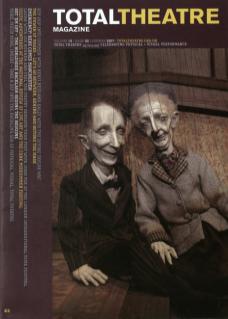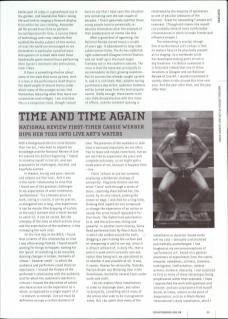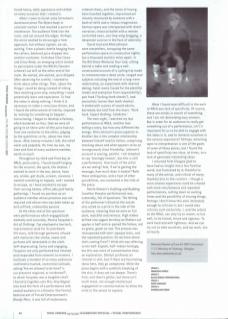With a background which is more theatre than live art, I was keen to expand my knowledge and the National Review of Live Art seemed the perfect beginning. I hoped to immerse myself in live art, and was prepared to be challenged, shocked, and hopefully excited.
In theatre, timing and pace, tension and release are fine tools. And it was in the works' relationship to time that I found one of the greatest challenges to my expectation of what constitutes 'performance'. For a theatre piece to work, timing is crucial; it can be precise, or elongated into a long, slow experience; it can be minute (the dropping of a plate at the exact moment that a hand reaches to catch it); it can be varied. But the interplay of the time at which actions occur and the expectation of the audience, is key in keeping the work vital.
On the first day at the NRLA, I found that in terms of this relationship to time I was often wrong-footed. I found myself waiting for things to happen; waiting for the 'point' of something to be revealed, desiring changes in tempo, moments of climax – however small – in which the audience and performers could share an experience. I missed the finesse of the performer's relationship with the audience, and for whom the audience's reaction is critical; I missed the discretion of artists who have an eye on the experience as a whole, as opposed to a single aspect of it – a texture, a concept. Live art must by definition occupy a certain duration of time. The presence of the audience in that time is variously important; we are often free to leave and maybe come back, but we are not free to experience the piece with complete autonomy, as we might with a made piece of art, because it happens then – live.
Claire 'refuses to use her surname, employing a deliberate strategy of anonymity'. Flagrante Delicto saw the artist 'Claire' walk through a series of doors, slamming them behind her, the sound, by its very nature, putting the viewer on edge. I watched for a long time, thinking that repetition can compound or change the experience of an action or sound; the artist herself repeated it for four hours. The rhythm had satisfaction to it, and the action was strong and powerful. In another room close by, Ginny Reed performed Until My Pencil Runs Out, in which she walked around the walls, dragging a pencil along the surface and re-sharpening it until it ran out. Since it is almost unheard of, in daily life, that a pencil is used until it actually runs out, rather than being lost, we speculated as to whether it was possible at all. It was, it seems. Hooray for rationality. Outside, Marilyn Arsem was Wintering Over in the Greenhouse, buried for several hours under earth and cloth.
I do not explain these installations in order to disparage them, but rather to demystify, something which many of the artists also seek to do in programme notes. But I do admit that many of the installation or duration-based works left me cold – sensually unstimulated and mentally unchallenged. I had laughed at my own preconceptions of 'performance art', based on a general awareness of experiments from the sixties onwards: nakedness, stillness, slowness, nothingness; confrontation, random actions, violence, obscurity. I was surprised to find so many of these stereotypes being perpetuated rather than exploded. I hope I approached the work with openness and interest, and was surprised to find myself bored, at times, almost to the point of desperation, such as in Black Market International's daily installation, which I found heavy, dully oppressive and stilted on every occasion that I visited it.
When I came to Sarah-Jane Grimshaw's durational piece The Abject body in constant motion I had reached a point of intolerance. The audience filed into the room, and sat around the edges. Perhaps the artist wanted to encourage a freer approach, but without signals, we sat, waiting. From a plastic bottle hanging from the rafters, beetroot juice dripped into another container. Grimshaw (like Claire and Ginny Reed, an emerging artist invited to participate under the NRLA's Elevator scheme) sat still at the other end of the room. We waited, she waited, juice dripped. After observing for a while, I started to think about other things. Then, about the things I could be doing instead of sitting here watching juice drip, everything I could potentially learn and experience. To find the value in doing nothing, I think it is necessary to make a conscious choice, and I found the enforcement of inertia, imposed by 'waiting for something to happen', excruciating. I began to develop a fantasy, which bordered on fear, that we were all going to sit there until all the juice had run from one container to the other; judging by the quantities so far, about two more hours. After twenty minutes I left, the relief warm and palpable. My time my own, my time and that of every audience member, worth so much.
Throughout my third and final day at NRLA, particularly, I found myself longing for the visceral, the quick, the intense. I wanted to swim in the sea, dance, have sex, smoke, get drunk, scream, converse. I wanted something to happen, and I wanted to escape, as I have wanted to escape from nursing homes, office jobs and family gatherings. I found my position as an audience member whose presence was not required and whose time was both taken up and unfilled, unbearably passive.
At the other end of the spectrum were performances which engaged both mentally and viscerally. Marcia Farquhar's Act of Clothing: 7up employed a low tech, improvisatory style for its patchwork life story, told through garments infused with memories like smoke, sweat and perfume still detectable in the cloth. Self-deprecating, funny and engaging, Farquhar not only performed but listened and responded from moment to moment. I had been a member of so many audiences confined to hushed, reverential solitude, asking 'Are we allowed to be here? Is our presence required, or incidental?', to which Farquhar was a tangible relief. Charlotte Engelkes’ solo Miss Very Wagner also took the form of a performance with seated audience in a theatre-like format. Reminiscent of Forced Entertainment's Bloody Mess, it was full of exuberance, ordered chaos, and the sense of having been knocked together, improvised yet cleverly structured by someone with a bank of skills and a riotous imagination. German opera was interspersed with direct narrative, classical ballet with a remote controlled swan, one limp wing dragging, a desperate survivor in the face of adversity.
David Izod and Allen Johnson were storytellers. Occupying the same performance space on consecutive nights, but a thousand stylistic miles apart. In The Bill Dixon Memorial Tour, Izod, sitting behind a table and reading a well-constructed account of a cycling trip made to commemorate a dead uncle, ranged over subjects including the end of a long-term relationship, an experiment with internet dating, hotel rooms (loved for the plentiful towels and exemption from responsibility), pub food ('fucking lamb shanks'), and journalists (worse than lamb shanks). It ended with a piece of sound advice, borrowed, but told from the heart: 'Work hard. Expect Nothing. Celebrate.'
The next night, I watched my last performance at NRLA, another man telling a story, but how very different the energy. Allen Johnson's preoccupation in Another You is the complex relationship between himself and his father, comprising shocking abuse and what appears to be an incongruously close friendship. Johnson's account is searing, painful. I am tempted to say 'searingly honest’, but this is still a performance. How much of the artist are we seeing? And, if we're getting the message, how much does it matter? Both these ambiguities, and a host of other possibilities, are contained in the title of the piece.
Sheila Ghelani's Grafting and Budding (another Elevator performance) was, ostensibly, full of questions. The letting of the performer's blood at the outset also acted as a prick in the side of the audience, meaning that we were on full alert, watchful and nervous. High stakes drifted into vaguer territory as Ghelani cut apples in half and re-paired the halves; red on green, green on red. This process was interspersed with semi-opaque texts, and the repeated question: Do we know where she's coming from? I think she was referring to her half-English, half-Indian heritage, but this was more of a presentation than an exploration. Ghelani professes an interest in skin, but if there are fascinating ideas here, they go unexplored. While the piece begins with a symbolic breaking of the skin, it does not cut deeper. There's fruit, and there's glitter, but there isn't much meat, not enough intellectual engagement or communication to allow the mind or the senses to explore.
What I found most difficult in the work at NRLA was lack of specificity. Of course, these are artists in search of something, and I am not demanding easy answers. But in order for an audience to really get something out of a performance, isn't it important for us to be able to engage with the ideas in it, and to immerse ourselves in the sensory experience? Perhaps remaining open to interpretation is one of the goals of some of these pieces, but I found the lack of specificity too close, at times, to a lack of genuinely interesting ideas.
I returned from Glasgow glad to have had an insight into a less familiar world, but frustrated by it; thankful to many of the artists, and critical of many; thankful also to the curators – though a more intense experience could be created with more simultaneous and repeated performances, cutting down on waiting times and the possibility of missing things. Perhaps I don't know this work intimately enough to criticise it; but I would also criticise such exclusivity. I, and the artists at the NRLA, can only try to invent, to live well, to be honest, brave and rigorous. To work hard and with lightness. And we can try not to take ourselves, and our work, too seriously.


